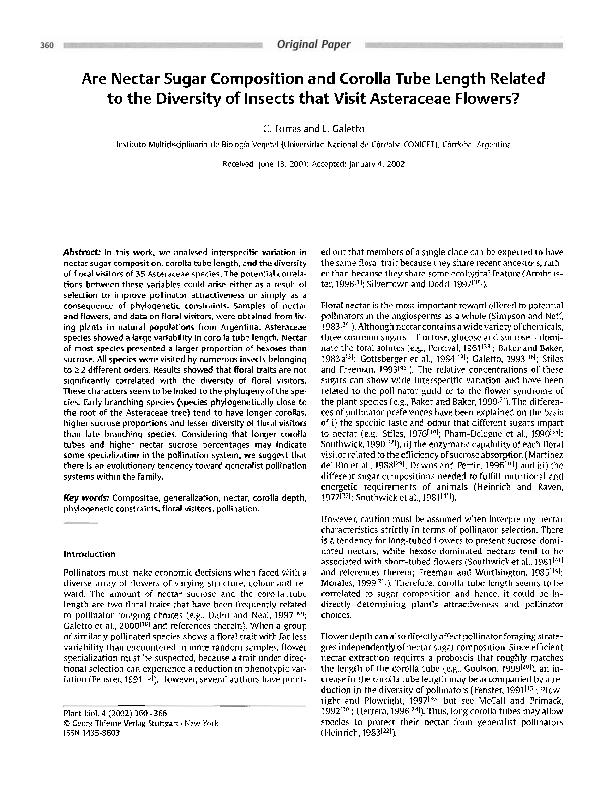Artículo
Are nectar sugar composition and corolla tube length related to the diversity of insects that visit Asteraceae flowers?
Fecha de publicación:
12/2002
Editorial:
Wiley Blackwell Publishing, Inc
Revista:
Plant Biology
ISSN:
1435-8603
e-ISSN:
1438-8677
Idioma:
Inglés
Tipo de recurso:
Artículo publicado
Clasificación temática:
Resumen
In this work, we analysed interspecific variation in nectar sugar composition, corolla tube length, and the diversity of floral visitors of 35 Asteraceae species. The potential correlations between these variables could arise either as a result of selection to improve pollinator attractiveness or simply as a consequence of phylogenetic constraints. Samples of nectar and flowers, and data on floral visitors, were obtained from living plants in natural populations from Argentina. Asteraceae species showed a large variability in corolla tube length. Nectar of most species presented a larger proportion of hexoses than sucrose. All species were visited by numerous insects belonging to ≥ 2 different orders. Results showed that floral traits are not significantly correlated with the diversity of floral visitors. These characters seem to be linked to the phylogeny of the species. Early branching species (species phylogenetically close to the root of the Asteraceae tree) tend to have longer corollas, higher sucrose proportions and lesser diversity of floral visitors than late branching species. Considering that longer corolla tubes and higher nectar sucrose percentages may indicate some specialization in the pollination system, we suggest that there is an evolutionary tendency toward generalist pollination systems within the family.
Archivos asociados
Licencia
Identificadores
Colecciones
Articulos(IMBIV)
Articulos de INST.MULTIDISCIPL.DE BIOLOGIA VEGETAL (P)
Articulos de INST.MULTIDISCIPL.DE BIOLOGIA VEGETAL (P)
Citación
Torres, Carolina Cecilia; Galetto, Leonardo; Are nectar sugar composition and corolla tube length related to the diversity of insects that visit Asteraceae flowers?; Wiley Blackwell Publishing, Inc; Plant Biology; 4; 3; 12-2002; 360-366
Compartir
Altmétricas




